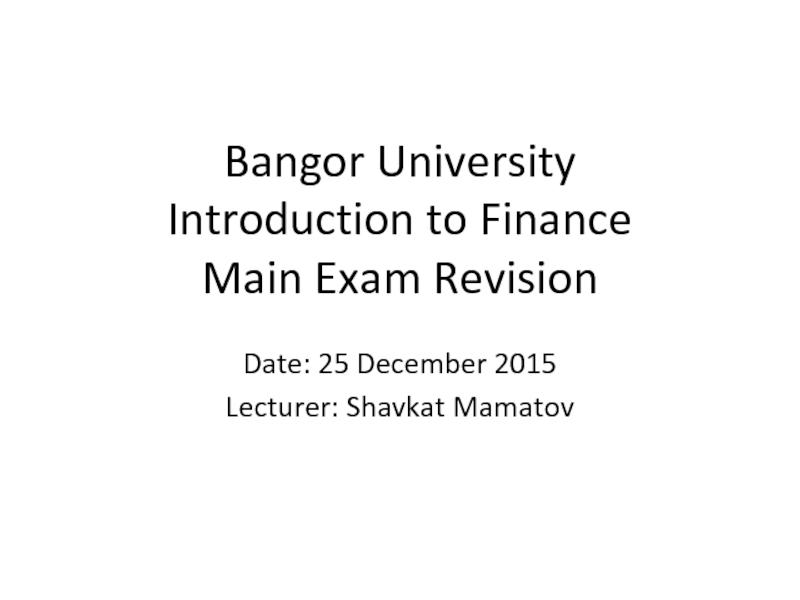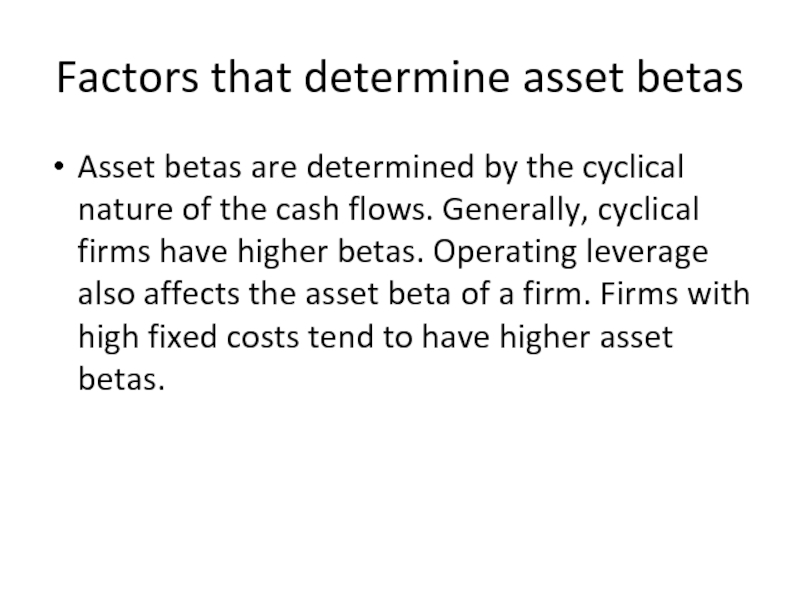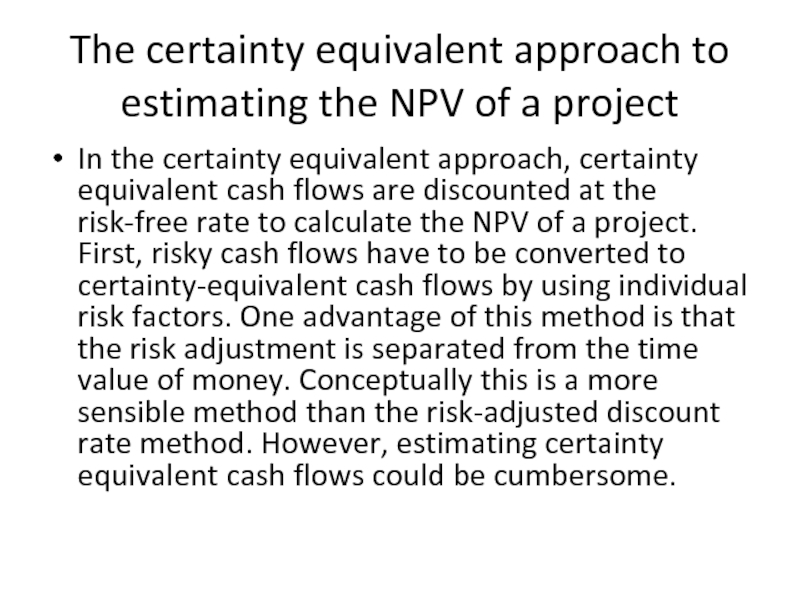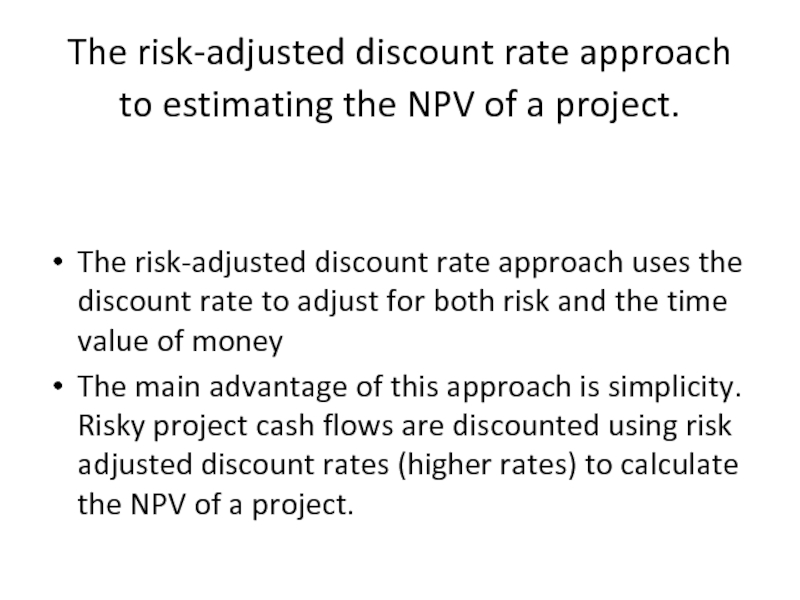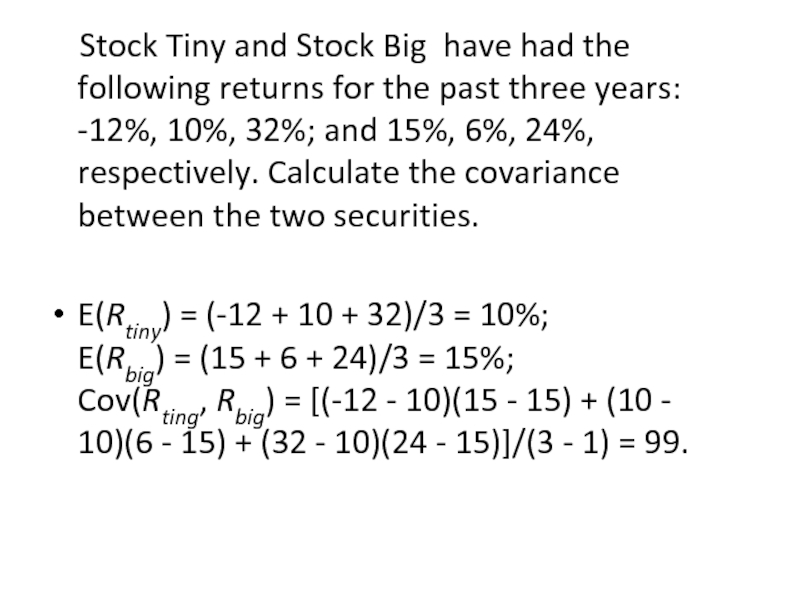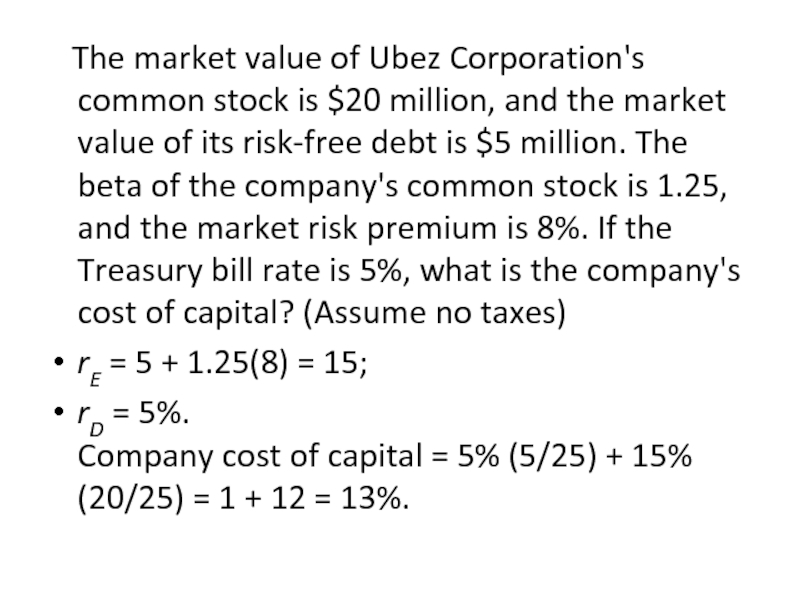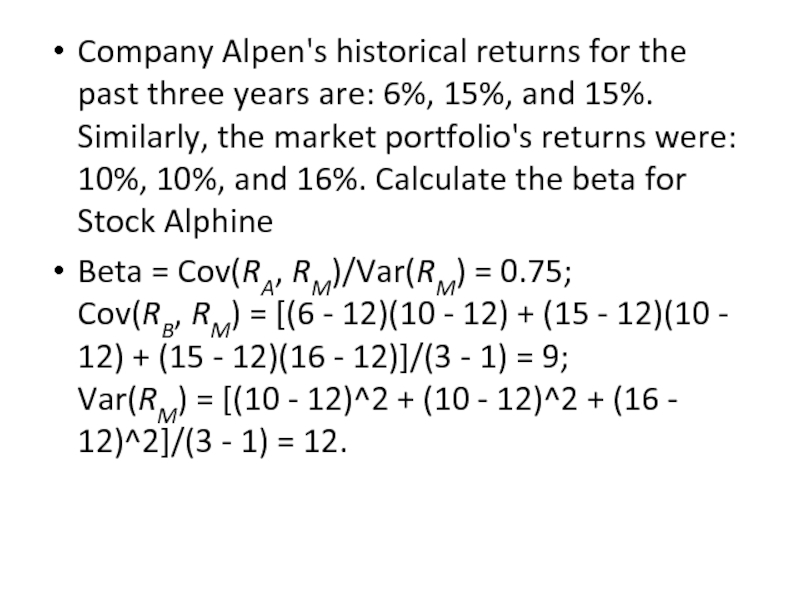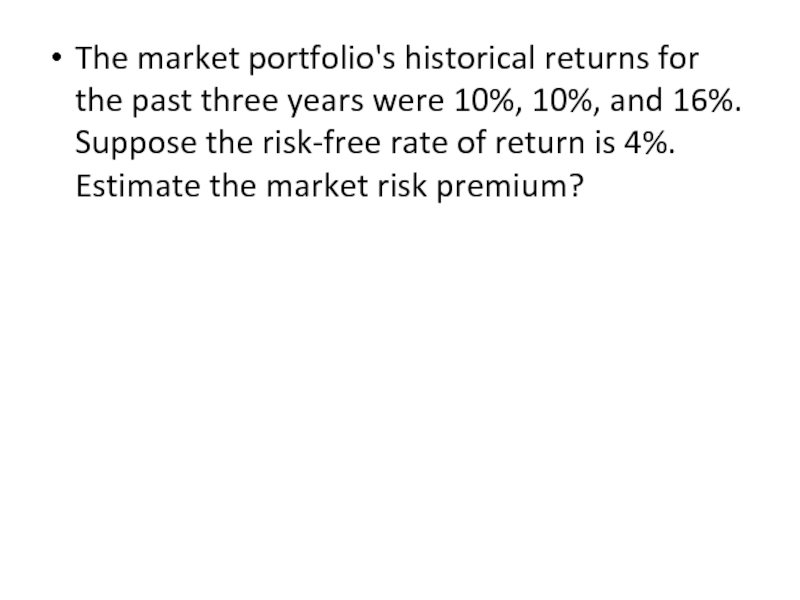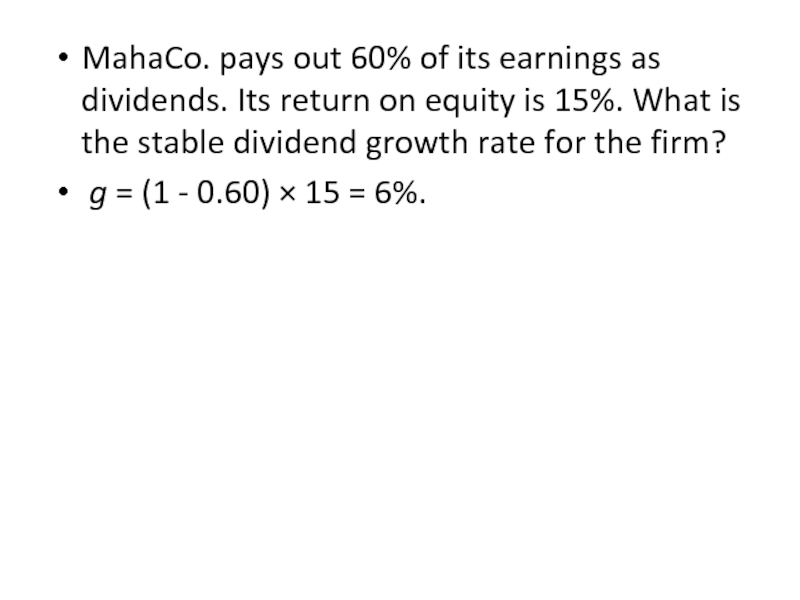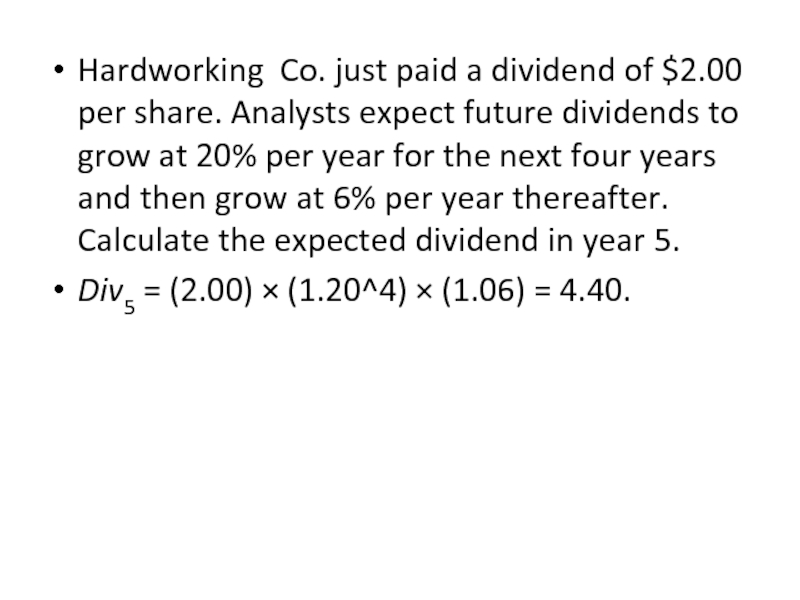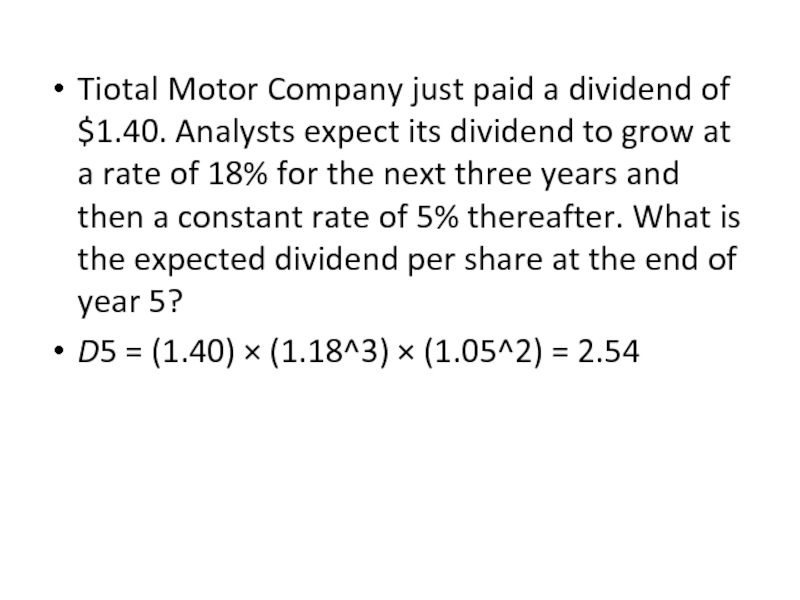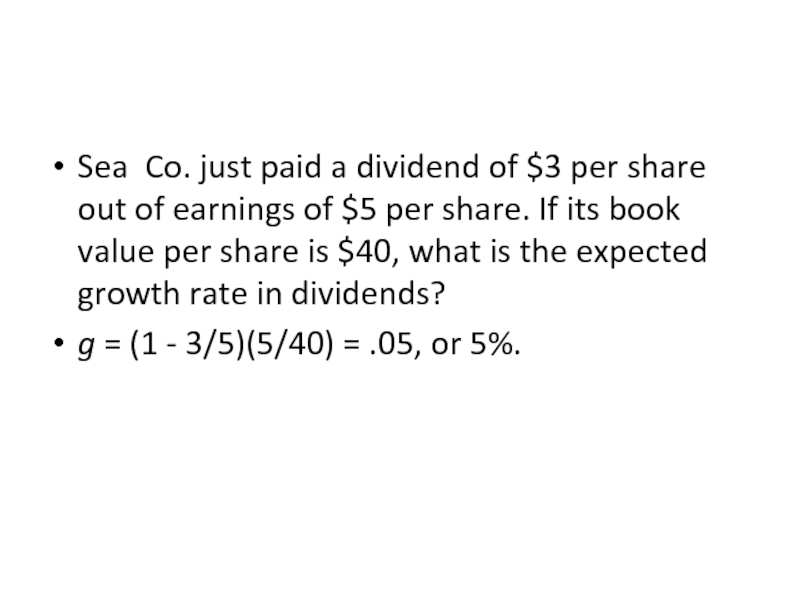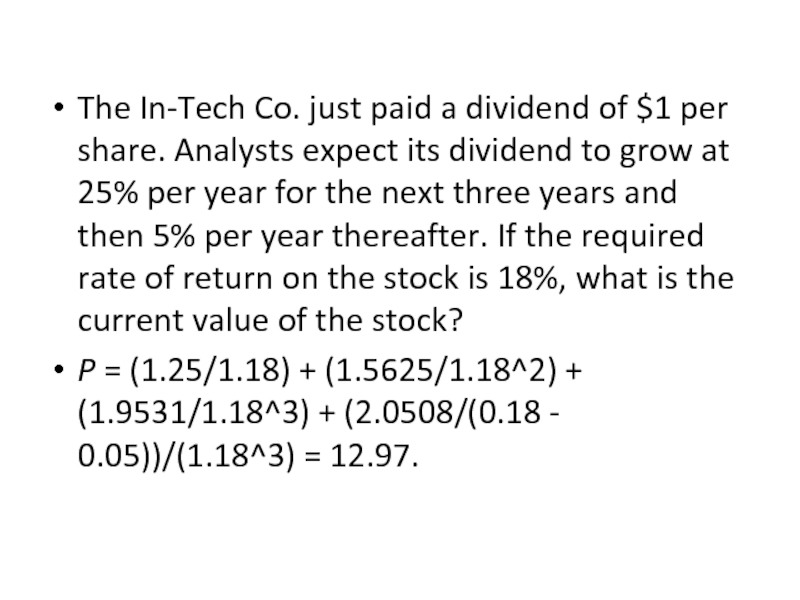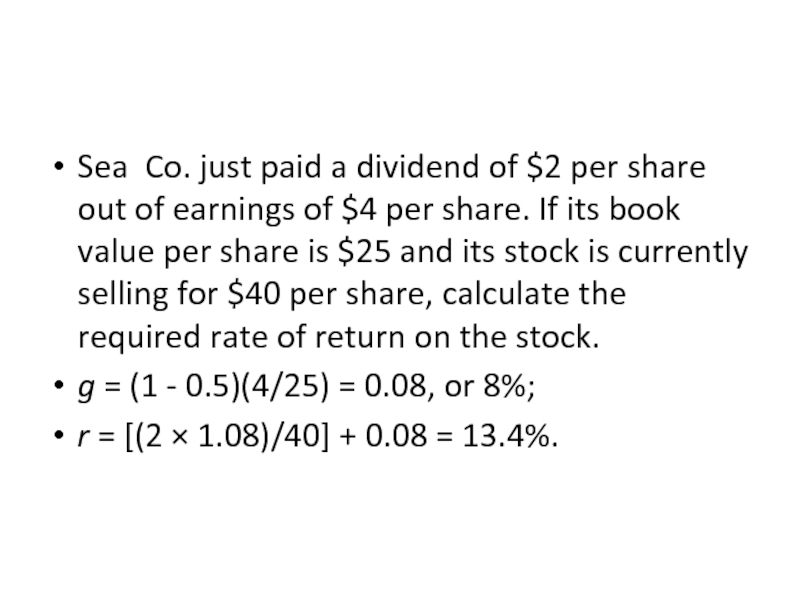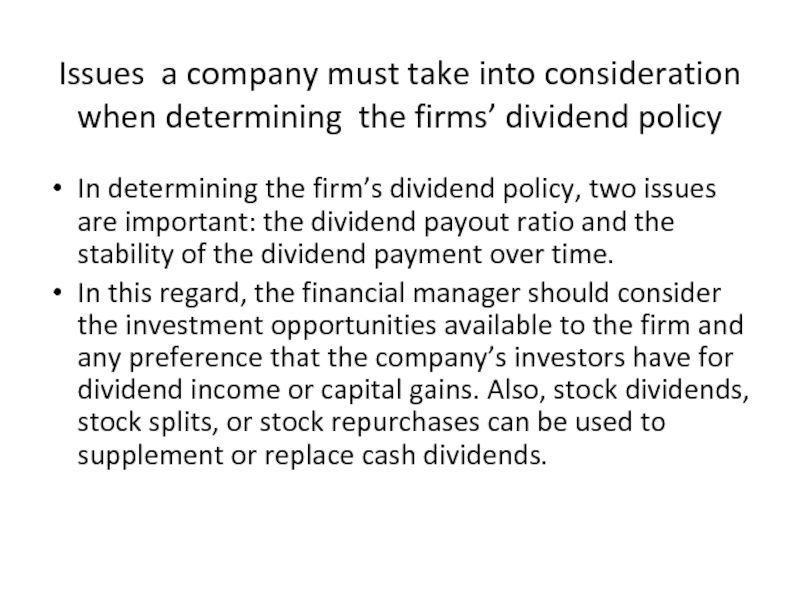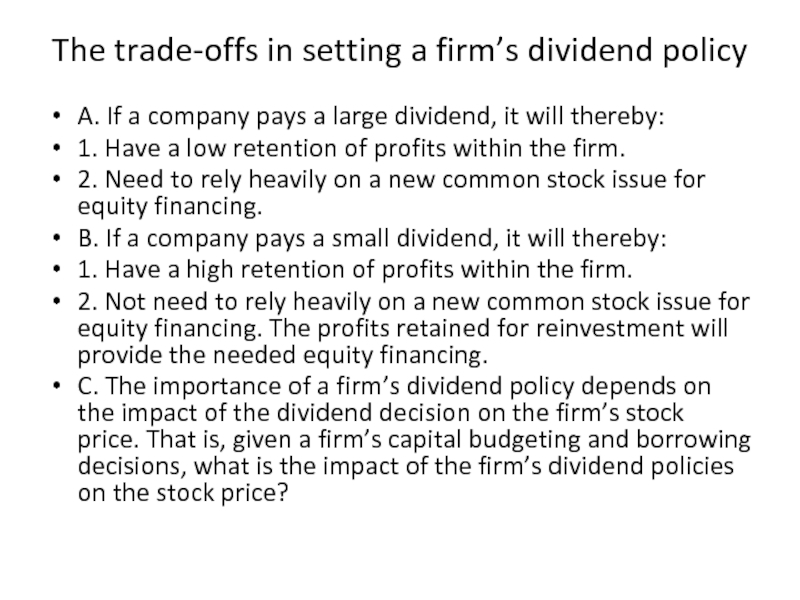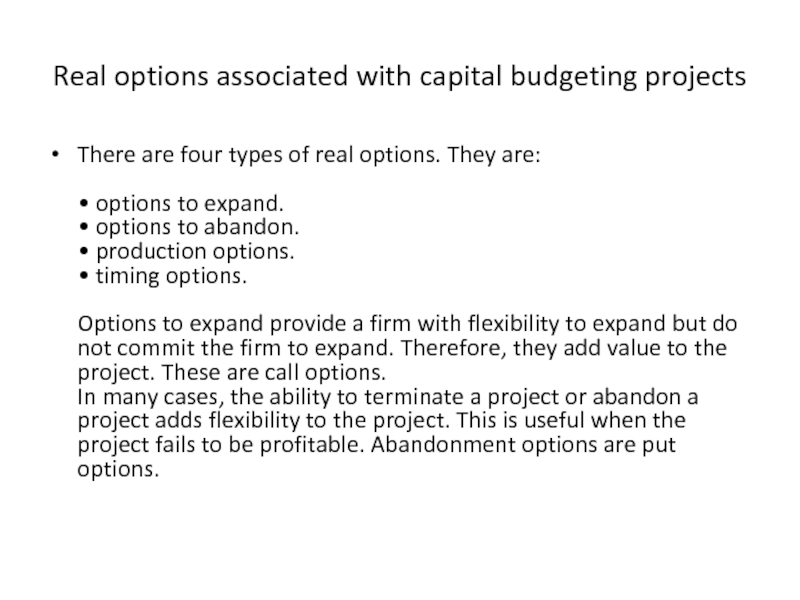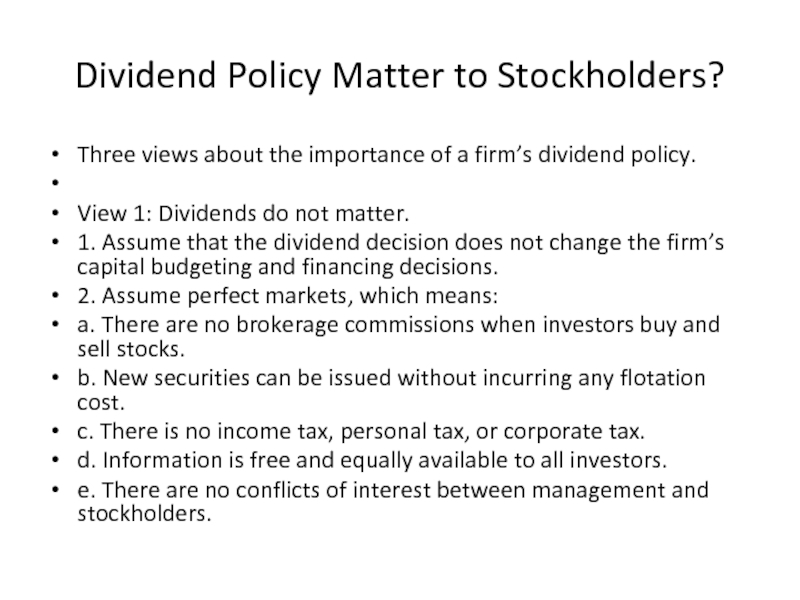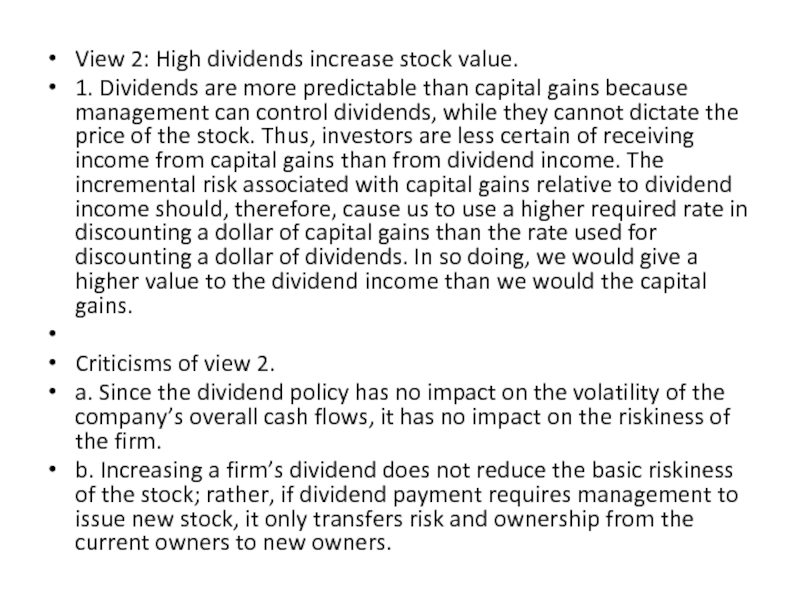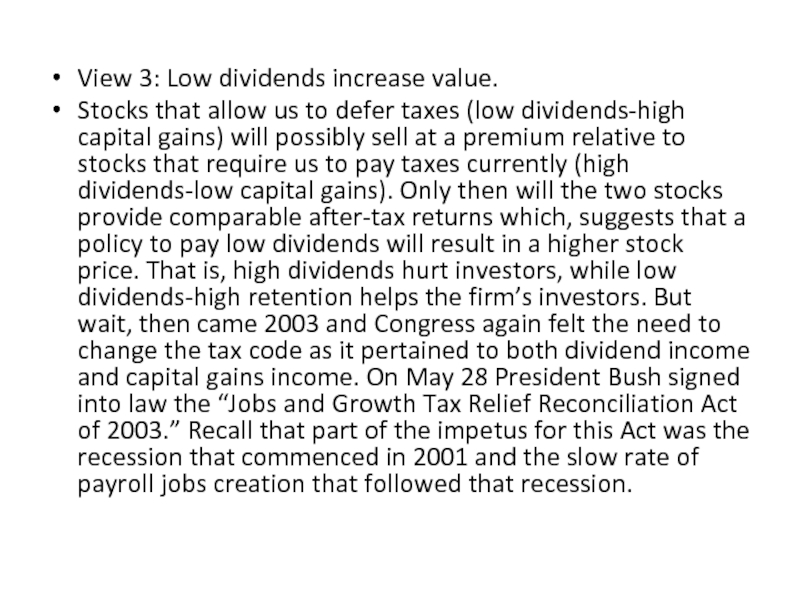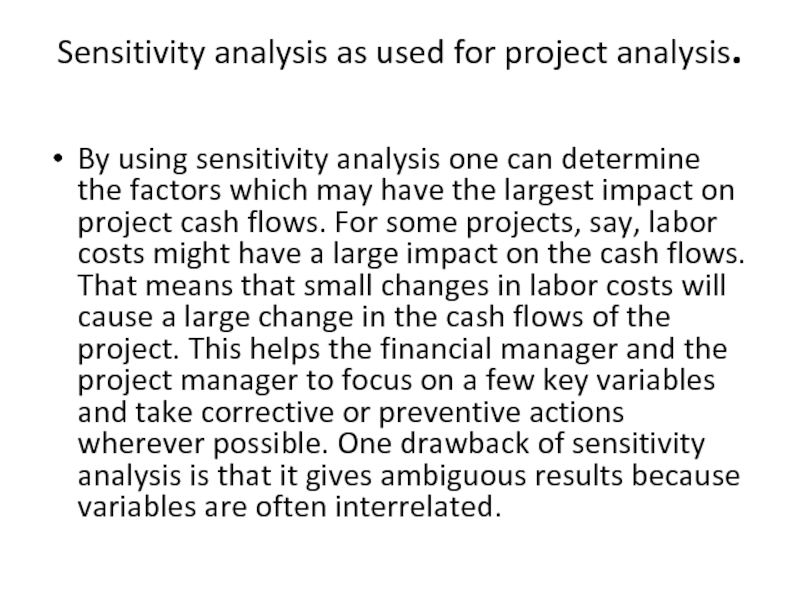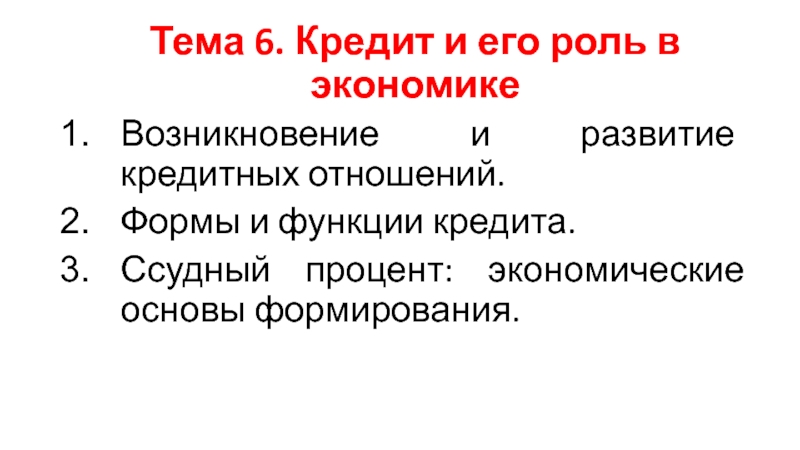- Главная
- Разное
- Дизайн
- Бизнес и предпринимательство
- Аналитика
- Образование
- Развлечения
- Красота и здоровье
- Финансы
- Государство
- Путешествия
- Спорт
- Недвижимость
- Армия
- Графика
- Культурология
- Еда и кулинария
- Лингвистика
- Английский язык
- Астрономия
- Алгебра
- Биология
- География
- Детские презентации
- Информатика
- История
- Литература
- Маркетинг
- Математика
- Медицина
- Менеджмент
- Музыка
- МХК
- Немецкий язык
- ОБЖ
- Обществознание
- Окружающий мир
- Педагогика
- Русский язык
- Технология
- Физика
- Философия
- Химия
- Шаблоны, картинки для презентаций
- Экология
- Экономика
- Юриспруденция
Introduction to finance презентация
Содержание
- 1. Introduction to finance
- 2. Firm's cost of equity is estimated using
- 3. When using the CAPM, which value should
- 4. Factors that determine asset betas Asset betas
- 5. The certainty equivalent approach to estimating the
- 6. The risk-adjusted discount rate approach to estimating
- 7. Stock Tiny and Stock Big
- 8. The market value of Ubez
- 9. The market value of Funny Corporation's common
- 10. Company Alpen's historical returns for the past
- 11. The market portfolio's historical returns for the
- 12. MahaCo. pays out 60% of its earnings
- 13. Hardworking Co. just paid a dividend of
- 14. Tiotal Motor Company just paid a dividend
- 15. Sea Co. just paid a dividend of
- 16. The In-Tech Co. just paid a dividend
- 17. Sea Co. just paid a dividend of
- 18. Issues a company must take into consideration
- 19. The trade-offs in setting a firm’s dividend
- 20. Real options associated with capital budgeting projects
- 21. Production options provide a firm with additional
- 22. Dividend Policy Matter to Stockholders? Three views
- 23. 3. Under the foregoing assumptions, it may
- 24. View 2: High dividends increase stock value.
- 25. View 3: Low dividends increase value. Stocks
- 26. Sensitivity analysis as used for project analysis.
- 27. The term price-earnings (P/E) ratio The P/E
- 28. The assumptions associated with the constant dividend
Слайд 1Bangor University
Introduction to Finance
Main Exam Revision
Date: 25 December 2015
Lecturer:
Слайд 2Firm's cost of equity is estimated using the capital asset pricing
The first step estimates the beta of the firm's common stock by regressing the returns on the stock on the market returns using historical data. The expected stock return is estimated using CAPM:
E(R) = rf + (beta)(rm – rf)
Expected return is the estimate of the firm's cost of equity.
Слайд 3When using the CAPM, which value should be used for the
Generally, the value used for the risk-free rate is the short-term U.S. Treasury bill rate.
Слайд 4Factors that determine asset betas
Asset betas are determined by the cyclical
Слайд 5The certainty equivalent approach to estimating the NPV of a project
In
Слайд 6The risk-adjusted discount rate approach to estimating the NPV of a
The risk-adjusted discount rate approach uses the discount rate to adjust for both risk and the time value of money
The main advantage of this approach is simplicity. Risky project cash flows are discounted using risk adjusted discount rates (higher rates) to calculate the NPV of a project.
Слайд 7 Stock Tiny and Stock Big have had the following
E(Rtiny) = (-12 + 10 + 32)/3 = 10%; E(Rbig) = (15 + 6 + 24)/3 = 15%; Cov(Rting, Rbig) = [(-12 - 10)(15 - 15) + (10 - 10)(6 - 15) + (32 - 10)(24 - 15)]/(3 - 1) = 99.
Слайд 8 The market value of Ubez Corporation's common stock is
rE = 5 + 1.25(8) = 15;
rD = 5%. Company cost of capital = 5% (5/25) + 15% (20/25) = 1 + 12 = 13%.
Слайд 9The market value of Funny Corporation's common stock is $40 million
rE = 6 + 0.8(10) = 14%;
rD = 5%;
cost of capital = (60/100)(6%) + (40/100) (14%) = 9.2%.
Слайд 10Company Alpen's historical returns for the past three years are: 6%,
Beta = Cov(RA, RM)/Var(RM) = 0.75; Cov(RB, RM) = [(6 - 12)(10 - 12) + (15 - 12)(10 - 12) + (15 - 12)(16 - 12)]/(3 - 1) = 9; Var(RM) = [(10 - 12)^2 + (10 - 12)^2 + (16 - 12)^2]/(3 - 1) = 12.
Слайд 11The market portfolio's historical returns for the past three years were
Слайд 12MahaCo. pays out 60% of its earnings as dividends. Its return
g = (1 - 0.60) × 15 = 6%.
Слайд 13Hardworking Co. just paid a dividend of $2.00 per share. Analysts
Div5 = (2.00) × (1.20^4) × (1.06) = 4.40.
Слайд 14Tiotal Motor Company just paid a dividend of $1.40. Analysts expect
D5 = (1.40) × (1.18^3) × (1.05^2) = 2.54
Слайд 15Sea Co. just paid a dividend of $3 per share out
g = (1 - 3/5)(5/40) = .05, or 5%.
Слайд 16The In-Tech Co. just paid a dividend of $1 per share.
P = (1.25/1.18) + (1.5625/1.18^2) + (1.9531/1.18^3) + (2.0508/(0.18 - 0.05))/(1.18^3) = 12.97.
Слайд 17Sea Co. just paid a dividend of $2 per share out
g = (1 - 0.5)(4/25) = 0.08, or 8%;
r = [(2 × 1.08)/40] + 0.08 = 13.4%.
Слайд 18Issues a company must take into consideration when determining the firms’
In determining the firm’s dividend policy, two issues are important: the dividend payout ratio and the stability of the dividend payment over time.
In this regard, the financial manager should consider the investment opportunities available to the firm and any preference that the company’s investors have for dividend income or capital gains. Also, stock dividends, stock splits, or stock repurchases can be used to supplement or replace cash dividends.
Слайд 19The trade-offs in setting a firm’s dividend policy
A. If a company
1. Have a low retention of profits within the firm.
2. Need to rely heavily on a new common stock issue for equity financing.
B. If a company pays a small dividend, it will thereby:
1. Have a high retention of profits within the firm.
2. Not need to rely heavily on a new common stock issue for equity financing. The profits retained for reinvestment will provide the needed equity financing.
C. The importance of a firm’s dividend policy depends on the impact of the dividend decision on the firm’s stock price. That is, given a firm’s capital budgeting and borrowing decisions, what is the impact of the firm’s dividend policies on the stock price?
Слайд 20Real options associated with capital budgeting projects
There are four types of
Слайд 21Production options provide a firm with additional flexibility to alter inputs
Слайд 22Dividend Policy Matter to Stockholders?
Three views about the importance of a
View 1: Dividends do not matter.
1. Assume that the dividend decision does not change the firm’s capital budgeting and financing decisions.
2. Assume perfect markets, which means:
a. There are no brokerage commissions when investors buy and sell stocks.
b. New securities can be issued without incurring any flotation cost.
c. There is no income tax, personal tax, or corporate tax.
d. Information is free and equally available to all investors.
e. There are no conflicts of interest between management and stockholders.
Слайд 233. Under the foregoing assumptions, it may be shown that the
Слайд 24View 2: High dividends increase stock value.
1. Dividends are more predictable
Criticisms of view 2.
a. Since the dividend policy has no impact on the volatility of the company’s overall cash flows, it has no impact on the riskiness of the firm.
b. Increasing a firm’s dividend does not reduce the basic riskiness of the stock; rather, if dividend payment requires management to issue new stock, it only transfers risk and ownership from the current owners to new owners.
